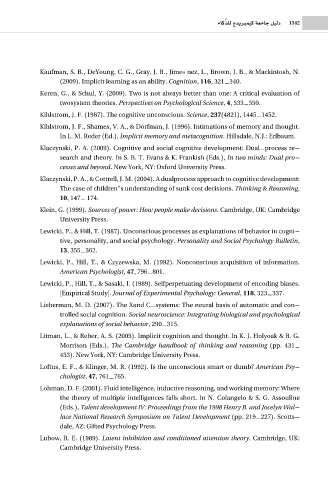Page 1343 - theCambridgehandbookofintelligence1
P. 1343
AÉcòs ∏d êójôѪ«c á©eÉL π«dO 1342
Kaufman, S. B., DeYoung, C. G., Gray, J. R., Jime« nez, L., Brown, J. B., & Mackintosh, N.
(2009). Implicit learning as an ability. Cognition, 116, 321-340.
Keren, G., & Schul, Y. (2009). Two is not always better than one: A critical evaluation of
twosystem theories. Perspectives on Psychological Science, 4, 533-550.
Kihlstrom, J. F. (1987). The cognitive unconscious. Science, 237(4821), 1445-1452.
Kihlstrom, J. F., Shames, V. A., & Dorfman, J. (1996). Intimations of memory and thought.
In L. M. Reder (Ed.), Implicit memory and metacognition. Hillsdale, N.J.: Erlbaum.
Klaczynski, P. A. (2009). Cognitive and social cognitive development: Dual-process re-
search and theory. In S. B. T. Evans & K. Frankish (Eds.), In two minds: Dual pro-
cesses and beyond. New York, NY: Oxford University Press.
Klaczynski, P. A., & Cottrell, J. M. (2004). A dualprocess approach to cognitive development:
The case of children s understanding of sunk cost decisions. Thinking & Reasoning,
10, 147- 174.
Klein, G. (1999). Sources of power: How people make decisions. Cambridge, UK: Cambridge
University Press.
Lewicki, P., & Hill, T. (1987). Unconscious processes as explanations of behavior in cogni-
tive, personality, and social psychology. Personality and Social Psychology Bulletin,
13, 355-362.
Lewicki, P., Hill, T., & Czyzewska, M. (1992). Nonconscious acquisition of information.
American Psychologist, 47, 796-801.
Lewicki, P., Hill, T., & Sasaki, I. (1989). Selfperpetuating development of encoding biases.
[Empirical Study]. Journal of Experimental Psychology: General, 118, 323-337.
Lieberman, M. D. (2007). The Xand C-systems: The neural basis of automatic and con-
trolled social cognition. Social neuroscience: Integrating biological and psychological
explanations of social behavior, 290-315.
Litman, L., & Reber, A. S. (2005). Implicit cognition and thought. In K. J. Holyoak & R. G.
Morrison (Eds.), The Cambridge handbook of thinking and reasoning (pp. 431-
453). New York, NY: Cambridge University Press.
Loftus, E. F., & Klinger, M. R. (1992). Is the unconscious smart or dumb? American Psy-
chologist, 47, 761-765.
Lohman, D. F. (2001). Fluid intelligence, inductive reasoning, and working memory: Where
the theory of multiple intelligences falls short. In N. Colangelo & S. G. Assouline
(Eds.), Talent development IV: Proceedings from the 1998 Henry B. and Jocelyn Wal-
lace National Research Symposium on Talent Development (pp. 219-227). Scotts-
dale, AZ: Gifted Psychology Press.
Lubow, R. E. (1989). Latent inhibition and conditioned attention theory. Cambridge, UK:
Cambridge University Press.

